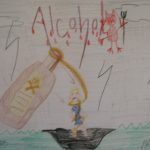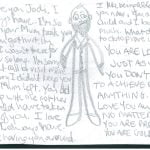Some thoughts on parenting – combining insights from neuroscience, new biological sciences, conscious parenting, and psychology.
 Children need love and affection
Children need love and affection
Children need to feel loved and accepted in order for their brains to develop optimally. Even prior to the formation of your egg or sperm your thoughts about yourself, the world and your desire or not to have a child and your ability to care for that child or not, start shaping the personality of a possible child. Your thoughts affect what genes are selected and programmed on your egg or sperm. So even prior to conception you have the ability to affect the personality and intelligence of your child.
Children need your time and attention
Even in the womb children benefit from you connecting with them, talking to them, telling them they are loved, wanted, welcomed, that the world is a safe place, that you look forward to sharing your life with them. This prenatal attachment helps your baby’s brain to grow in optimal ways.

If the Mother is very stressed then her body is full of cortisol and this is toxic to a developing baby’s brain. It actually eats away / dissolves the brain cells. (The same happens when a baby is left to cry – cortisol is secreted and can damage the brain). What you do during your pregnancy has a major impact on the development of your child-to-be’s IQ and physiology. Up to half of their personality is already formed before they are even born.
Children need loving births and to bond with you immediately
The birth process also affects the child and its experience of the world. Is it stressful, noisy, loud and invasive – like a hospital can be? Was the birth traumatic with the Mother and Father in fear? Were there any complications? Was the baby taken from the Mother and tested for various things – pricked in the foot for blood tests, immunised, a plastic scapula stuck down its throat to sample its stomach contents, weighed on a cold scale? All of these things affect the child’s perception of the world and whether it is safe, welcoming or not.

It is now being fully recognised by politicians and community health personnel that if you raise babies in a more loving and nurturing way those children will grow up with a healthier sense of self esteem and connection with society. Poor care giving leads to more crime, ill health, poverty and other undesirable characteristics. That is why Governments, including Australia, are introducing policies to support parents and improve early care giving. We will continue to see more and more early care services for families as this recognition becomes widely accepted in society.
Parents need help to look after their babies optimally. Parenting is a hard job. It requires you to give and give and give. If you are stressed, resentful, depressed or even just unhappy with your life – your baby absorbs that and may believe it is their fault. Setting up beliefs of “I’m a problem”, “I’m not good enough”. Even if they don’t do that, they learn about life from you, so they will automatically expect their life to be the same.
Children learn from your every move
From 0-6 years of age their brains have not developed conscious functioning – the ability to question data. From 0-6 years they simply believe everything that they are told or what they see and sense about the world from watching you. If they see you sad or scared or stressed, they absorb it. If they hear you say that they are bad, unwanted, have spoilt things, are selfish, stupid, you wish they were never born, etc, they absorb it and believe it. This forms their core belief system that will then affect them for the rest of their life.
Parents, most anyway, do not set out to damage their children, but when they are stressed and exhausted such statements can slip out. Especially if that is what you were told when you were little. Your parents programmed your beliefs from 0-6 years of age as you do with your children. These patterns can repeat through the generations unless you make a conscious decision to heal and change those beliefs – then your actions can be different.
Conscious parenting is a great start, learning what you can about loving and nurturing methods to promote a baby and child’s self esteem, individuality and emotional intelligence. The knowledge is key. You will be able to apply it when you are calm, centred and feeling good. But when you are stressed you may be shocked to find that you revert back to not so ideal ways of talking to and treating your baby or child. You may hear your Mother’s of Father’s words coming out of your own mouth. Because when you are stressed you react more from the subconscious mind, on auto pilot. And this is the part of the brain that was programmed from 0-6 years old. It contains all the memories, feelings, beliefs form those times and plays them like tape recordings over and over. It does not judge or think it just plays over and over. Changing these tapes to more loving ones about yourself, your ability to be a good parent, about your child is crucial to good child rearing. It is this information which is now leading to greater support for families. With less stress it is easier to be more loving and kind to your child.
Parents need support
Whether it just be friends or family who can help around the house – getting drinks, meals, cleaning up, taking older kids out so that parents can bond with a new baby or family and friends helping to hold the baby when it cries so the Mother and Father can rest.
Crying is a natural biological process for releasing tension and stress. Sometimes your baby just needs to cry. There is nothing that they need other than to be held and loved while they cry. This can be challenging to a parent, especially a first time parent, who assumes that they are doing something wrong. Their belief tapes play “I’m not good enough”, “I’m a bad parent”, “My baby doesn’t like me” or “My baby/toddler is deliberately trying to upset or disobey me”. (Some people do have these beliefs, believing that babies and toddlers are deliberately trying to upset them, but this is not possible, their brains have not developed that much yet. They are not wilfully disobeying, they are just being babies/toddlers. They don’t need judgment or punishment, they need love and acceptance.)
A constantly crying baby can wear a parent down and it is important that another caregiver is present to take over and hold the baby when the parent can no longer do so in a loving way. This does not occur in a lot of families and what happens instead is that the baby senses your stress, anger, desperation = danger. You may have started to pat or bounce them a little harder. You may have shoved a dummy or food in their mouth. You may have put them down and walked away. All of these responses tell a baby it is not safe to express my emotions. They learn to bury the tension inside their bodies, setting up a lifelong pattern of emotional regression and inability to ask for what they need. Using food to comfort a child can set it up for obesity and eating disorders in the future.
Children need to express their emotions
This pattern is usually reinforced during toddler years and beyond if the child is not allowed to express it’s emotions to you. Often a child will be unhappy with something that you have done or something you won’t let them do. Few parents let their child express this. It leads the parents to feel hurt or guilt, and they can’t handle it so they stifle the child instead. “Don’t talk back”. “Respect your elders”. “Because I said so”. Are all ways parents use to stop a child expressing itself.
Ideally children from a young age are taught it is okay to express their emotions. This can be role modelled using I statements. “When you do ….. I feel and I’d prefer …….” This is healthy. Children can also draw, write about what they feel. They can be taught to punch a pillow or kick the bed when they are angry and get their emotion out. Teach them that is okay but hitting a person or animal is not.

Children need boundaries not discipline
It’s perfectly okay, desirable and healthy even, for you to assert your needs and desires with your toddler and older children. Let them know you have needs. For instance “I need you to go to sleep now, so Mummy can rest too”. “I need you to tidy your room as it is getting hard for me to walk around and that upsets me”. “I need some time with Daddy now so please go to sleep. I’ve enjoyed our day together, now it’s sleep time”. A child is more likely to go to sleep hearing this than if you try to tell them “You need to sleep so you will be refreshed in the morning or so you can concentrate at school tomorrow”. The child doesn’t care about these things, they are in the future, not now. Explaining your needs helps them learn that you are human, that you have needs too, that you won’t always be able to give to them. That is good. It helps them learn to be considerate of others and to be a caring member of society.
Letting your child walk all over you, treat you poorly, get away with all sorts of undesirable behaviour is damaging to them and to you. They need boundaries. They need to be taught about morals and care for self, others and the planet. These things can be done naturally and easily if you use such positive communication processes as I statements, as you role model healthy emotional intelligence and teach them the same. Make activities and chores fun, a chance to connect, then they will gladly tidy their room, help with the dishes, etc. Show your appreciation of their help. Your genuine praise warms the heart of your child and builds their self esteem. They will do more of what you want to get that warm, good feeling about themselves. If you have this connection and bond, you don’t need to coerce, manipulate or shame a child into doing the right thing. They will do it because they love you, you love them, you’ve made it fun, you’ve explained why it is important to do and they will get that yummy feeling. This is the reward that means the most to them.
If however you use star charts and rewards like chocolate, toys or special outings, the child may do the desired behaviour but they do it because they want the reward. Not because it is the right thing or considerate thing to do. They don’t learn the moral. They learn to focus on achieving, success, consuming / materialism. This is not healthy or desirable for them or society or the planet. There are already too many people wasting their lives working hard to get material possessions they don’t really need, which pollute the Earth. What is needed or more beneficial is people recognising that what really matters is family, friends, love, connection with self and others, doing what you want, being yourself, enjoying life and honouring the Earth. This is much more balanced, much healthier.
We can role model this for our children. Choose to spend more time with them and go without the fancy gadget. Your child will benefit immensely as will you. With strong connection discipline problems don’t occur and any minor issues can be resolved quickly and easily through talking about each person’s needs, feelings and desires. Get children to problem solve – identify different options and choose one. Get them to reflect on what happened, why and what could be done differently next time. This is a respectful and honouring way to resolve conflicts.

If a child is refusing to dress use natural consequences. Let them go outside without a jumper. When they get cold they’ll ask for it and they will have learnt why it is a good idea to wear one. Don’t fight and struggle. Find ways to make it easy, fun. Give a child a choice – “Today you can wear this or this outfit, which would you prefer?” Or let them choose out the wardrobe. Be prepared that they may not dress the way you like – a dress up outfit, mismatched clothing – but if they are happy, dressed and warm why should you care if it doesn’t match? That’s just societal conditioning about how we should do things. It does not mean you’re a bad parent if your child isn’t dressed traditionally. Let go of such thoughts.
Let your child play and their imaginations flourish. Don’t deaden life into routine and boring normality. Let their individuality shine through. This makes you a loving parent, one others could learn from. Do what your heart tells you is right, not what your head or mind says. If negative beliefs come up, look at them, heal them. There are a range of techniques that can be used to reprogram your subconscious mind with more positive and self supportive beliefs. Psych-K, the Lifeline Technique, even affirmations if done regularly, with feeling, looking into your own eyes in the mirror can do this. They can change the belief which leads to a rewiring of your brain. Science has now shown the truth of all this.
No parent can meet all their child’s needs all the time. Everyone falls short of the parenting ideal at times. Please do not beat yourself up about anything that may have happened in the past. You can’t change what has happened but you can commit to being a more conscious and nurturing parent now. Know that love heals and leads to reconnection.
For more information see:
Association for Prenatal and Perinatal Psychology and Health (APPAH) www.birthpsychology.com
The Alliance for Transforming the Lives of Children (ATLC) www.atlc.org
Natural Child www.naturalchild.org
Robin Grille’s 2005 book ‘Parenting for a peaceful world’ and 2008 book ‘Heart to heart parenting’
Bruce Lipton’s 2002 ‘Nature, nurture and the power of love: the biology of conscious parenting’ DVD. Bruce’s 2001 ‘The biology of perception’ DVD and 2005 book ‘Biology of beliefs’
Steve & Sharon Biddulph’s 2000 book ‘Love, laughter and parenting’
Thomas Gordon’s 1975 book ‘Parent Effectiveness Training’ – still one of the best!
Louise Hay’s 2007 ‘You can heal your life’ DVD, books and online courses
Rob Williams’ 2001 ‘The psychology of change’ DVD and 2004 book ‘Psych-K the missing piece peace in your life’.
Joe Dispensa’s, 2007, Evolve your brain: the science of changing your mind, DVD and book.
















